Samuel Metford (1810–1896), specialised in full-length silhouette likenesses on hand-painted watercolour backgrounds, sometimes embellished with gold and white paint or featuring gentrified interiors. Born in Glastonbury, Somerset, he received tuition from French silhouette artist Augustin Edouart, before going to America and working for the next ten years in New York, Philadelphia and Boston. His return to England in the mid-1840s coincided with the downturn in demand for profile portraits occasioned by photography which, by the 1860s, had rendered art forms such as the silhouette passé. This silhouette depicts the family of Francis MacKenzie (1806–1851, seated far right) at Adlington Hall in Standish, Lancashire. Following Francis MacKenzie’s death, his widow, Maria (1810–1874, third from left) emigrated to Australia with her five children. Maria’s eldest son, John (1833–1917, seated, left, at the table), was Examiner of Coalfields in the Illawarra from 1863 and 1865, later becoming Examiner of Coalfields for NSW. Her sons Walter (1835–1886, seated, right, at the table) and Kenneth (d. 1903) are thought to have become clergymen. Her youngest daughter, Maria (1842– 1917, second from left), married a doctor, Alexander Morson, in 1875. Another daughter, Caroline (1837–1922, fourth from left), remained unmarried and died at the family property near Dapto in 1922. Other sitters shown in the silhouette are Maria’s mother, Mrs Thomas Edwards (far left); and her youngest child, William, who died, aged six, in 1851. Maria MacKenzie died at Wallerawang in New South Wales in 1874. The silhouette was bequeathed to the Gallery by her great-grandaughter in 2007.
Gift of the Estate of Nancy Wiseman 2007
The MacKenzie Family silhouette by Samuel Metford was created in 1846. It is a brush and ink, pen and ink, stencil cut-out with watercolour highlights on paper. It measures 43 cm high by 64 cm wide.
This artwork depicts the family of Francis MacKenzie, whose family, after he died in 1856, settled in Australia.
The picture is a landscape format. The background is a large high-ceilinged room, depicted on a sepia-toned paper with delicate lines and minimal monochromatic watery grey highlights. Dominating the back wall are two large identical Georgian style windows. A thick curtain rod runs the breadth of both, finished with decorative round ends. Long drapes hang on either side of each window, cinched near their base and pooling on the floor. Through the windows there is a faint view of distant land and hills, two buildings and an empty sky. At the height of the window ledge a horizontal moulding runs the full distance of the room. The floor is covered in a pattern of repeating wide bands of circle motifs.
The family of nine are depicted in this scene in silhouette, cut from black paper with small additions of white and gold paint. Everyone is arranged in five groups spread evenly across the room.
On the far left in the foreground is an older woman and a young girl, facing each other. The older woman is seated in a high-backed rocking chair facing the right. She is diminutive, wearing a bonnet and a high-necked full-length dress with long sleeves. The young girl stands up straight with hair swept back in a low bun, wearing a dress with a scooped neck line with a bell-shaped skirt ending at her knees. In her right hand she is holding an open book in front of her chest.
To the right in the mid ground is a woman sitting straight in a low-backed dining chair, facing a girl to her right. The woman is wearing a bonnet and a full-length dress with a softly layered collar. The girl before her stands up straight, her head bent down slightly, her hair swept back in a low bun. She is dressed like the younger girl with the addition of long pantaloons. In her right hand she is holding up a single flower stem towards the woman.
To the right of this group, in the centre of the scene and positioned between the two large windows, are two boys sitting at a small round table. The first boy has short hair and is wearing a long sleeved short-waisted jacket with a white folded stiff collar and long pants, his right arm bent upward, his index finger pointing. Facing him is a similarly dressed smaller boy, also sitting straight on a dining chair, looking down, his right arm raised. A lamp illuminates the board game between them.
To the right in the foreground is a young child standing on their own facing the left. The child has short hair and is wearing a dress like the young girls. The child’s right hand is holding a long string attached to a small horse toy being pulled behind.
On the far right in the mid ground is a boy standing in front of a seated man. The boy is standing straight facing the right, dressed like the other boys. In his left hand he is balancing a model ship on his fingertips, holding it out towards the man. The man is sitting straight in a dining chair, wearing a long-sleeved jacket, with a crisp upturned white collar. His hands rest in his lap close to his body. His legs are crossed, right over left.
Audio description written by Marina Neilson and voiced by Annette Twyman, 2021
Samuel Metford (age 36 in 1846)
Maria Mackenzie (age 4 in 1846)
Francis Mackenzie (age 36 in 1846)
Caroline Jane Mackenzie (age 9 in 1846)
John Mackenzie (age 13 in 1846)
Walter Faulkes Mackenzie (age 11 in 1846)
William Mackenzie (age 1 in 1846)
Francis Mackenzie (age 40 in 1846)
Nancy Wiseman (1 portrait)



On one level The Companion talks about the most famous and frontline Australians, but on another it tells us about ourselves.
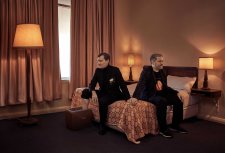
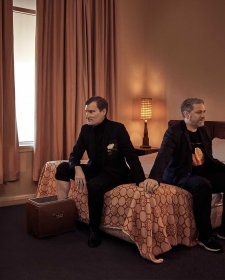
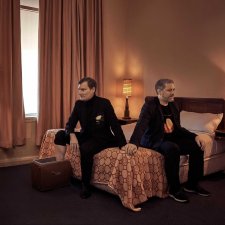
Sandra Bruce gazes on love and the portrait through Australian Love Stories’ multi-faceted prism.
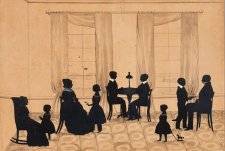
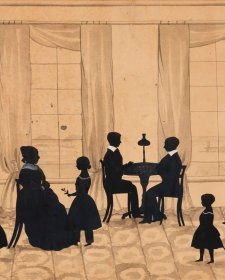
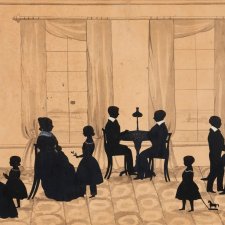
The National Portrait Gallery acquired a beguiling silhouette group portrait by Samuel Metford, an English artist who spent periods of his working life in America.